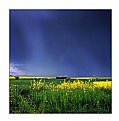Ann and Roger:
Quick manual for posterity under UF "articles":
If you want to start trying some for yourself:
Google on "Autostitch", it is a free program and is small. It just needs some RAM to go and runs on a PC. You open the preferences, set to 100% scale, 100 JPEG quality, and then open the files. It uses pattern recognition to match the shots, stretch, and blend. I've tried some other programs as well.
Arcsoft Panorama Maker is the next best in my experience. You are constrained by choosing one shot side to side, vertical, or matrix (4x4). You have to manually adjust the matching points. Does a great job.
Canon's Photostitch is neat - you enter in the mm of the lens (for digital users you have to convert to 35mm equivalent) and it merges and blends. Moderate results because if you do not line up the image plane you are in trouble.
Adobe Elements has Photomerge. Close to the Canon technology, but I just can't get this sucker to work for me. Probably user error.
To take a great stitch:
- Shoot digital. It's about matching pixels, and digital will get you the most consistent results (sharpness, tones, etc.)
- Use a tripod if you can. It's about moving the image plane (your sensor in your camera or film) along the same fulcrum. This means if you have a mounting point in line with that senor or film the tripod will force you to swivel right down the middle if you shoot in landscape mode.
- No tripod? It's OK. Remember that wider is not better. Perspective is a problem with shooting stitches, the more shifting of near ground elements due to a wide angle means you will have to overlap more. The "flatter" your images, the more two dimensional they are, the less "stretching" the software will have to do, or you will have to do using something like PT lens later on, to flatten the image for merging. When I shoot, I at most go to 28 mm at the widest, and in those cases I will do at least 50% overlap. At 70 mm and beyond, 1/4 overlap is the way to go.
- Use a grid system. My viewfinder projects a grid with lines on the quarter and one half as vertical lines and horizontal lines. I look at the cross-hatches where the lines intersect. For example, if I see that there is a tree at the intersection in the middle of my viewfinder, I remember that tree and then put it at the 1/4 intersection when I move the camera over. This makes sure that the perspective is forced to consistency as you turn the camera and everything will join smoothly. If you do not have grid lines you can use your autofoucs "dots" or eyeball it.
- Force everything manual. I look like an idiot by moving my camera around the whole scene, metering F-Stop and Exposure across the scene, and then choose the average and force the same: F-Stop, Exposure, White Balance, sharpening, etc across all the photos. This also means you have a lot less latitude to getting a really nice shot - in bright days the deep shadows and bright sky vary across the landscape. Sorry. Like most photos, the first and last hours of daylight are best. I do allow the autofocus to work, but with landscapes remember to use hyperfocal distance. Google "hyperfocal" if that just whizzed on by you. It just means using F-stop with where you focus to make sure everything winds up in focus. High depth of field (DOF).
- Lose the filters. Grad filters and polarizers will change the image as you move. IR, UV, ND, and other filters that are consistent are OK.
- Lastly, when you shoot leave room for cropping. Stitching programs love to stretch images, and you may find little blank spaces and gaps. The only way is to give a little buffer to your subjects and crop down later on. This is counter to the normal mode of cropping to the image you want in camera.
Have fun. You never know what will pop out until you are done stitching. I've noticed stitches of 20 images and discover that one of them was out of focus messing up the whole thing. Others that I thought would be boring wind up being absolutely great.
Another benefit is that if the image does not look a panorama, the end result is that you can get 18 - 24 megapixel images from a 6 megapixel camera. This means that you can get away with a wonderful 20" x 30" 150 dpi print for your wall.
|
















